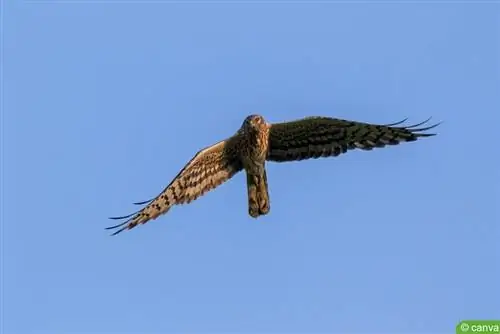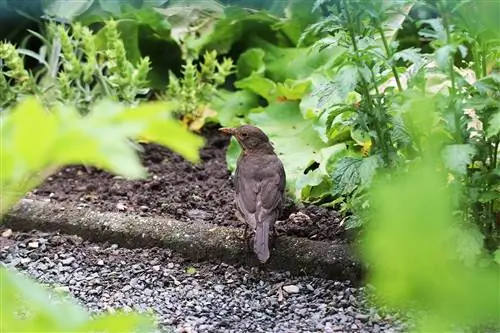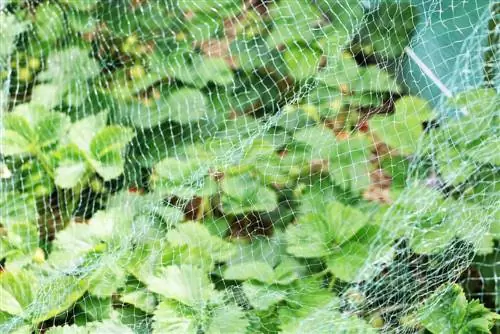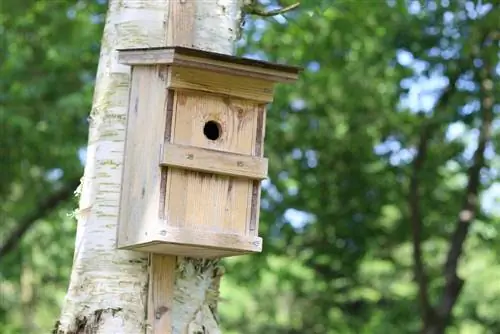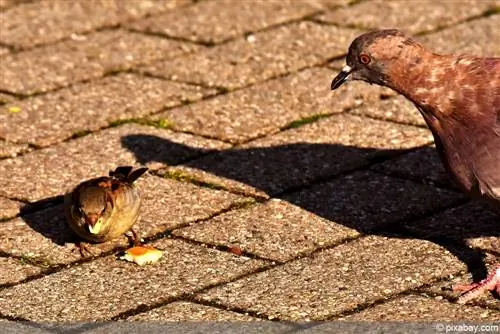- Author admin [email protected].
- Public 2023-12-17 03:39.
- Last modified 2025-06-01 06:48.
When a bird of prey makes its rounds over the fields or forests, it is fascinating. To make identifying the species a little easier, the list of small birds of prey in Germany was created.
Eagle (Aquila)
Not all eagles are big and clumsy. There are also species in our homeland that are smaller and more agile. However, the large and smaller species have one thing in common: they have broad wings and a slow wing beat, which is interrupted by a gliding flight on gliding routes.
Osprey (Pandion haliaetus)
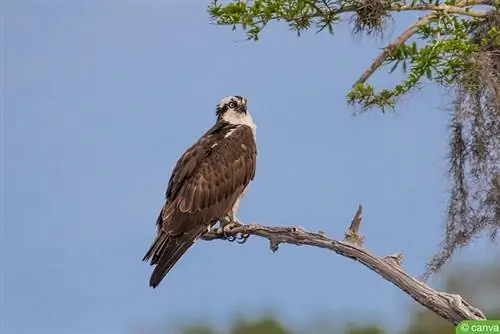
- Size like buzzard
- angled long wings
- brown plumage
- Bottom pure white
- Prey consists of fish, amphibians, small mammals and birds
- lives up to 30 years
- Migratory bird
- only in winter in local areas
Note:
Many of the birds of prey presented here are migratory birds that only spend the summer and breeding season or the winter with us. During the rest of the time these birds stay in other areas of Europe.
Snake Eagle (Circaetus gallicus)
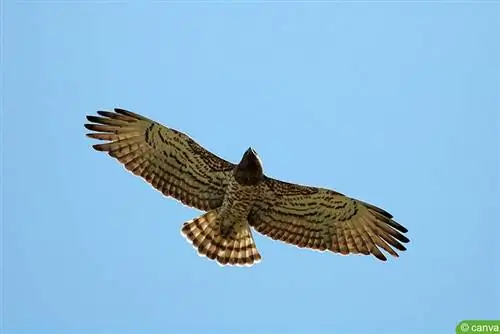
- has a noticeably large head
- otherwise only medium-sized
- bright underside
- Migratory bird
- only here in winter
- Prey small mammals and birds, reptiles, snakes
- lives up to 15 years
White Eagle (Aquila pomarina)
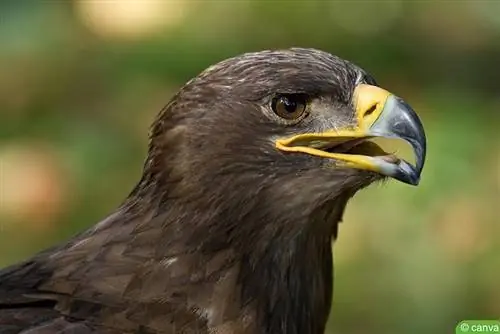
- small eagle species
- about 65 centimeters tall
- dark plumage
- whitish markings on tail
- less spotting in young birds
- breeds in East Germany
- Eyrie building on trees
- Migratory bird
- Food frogs, lizards, mice, snakes and carrion
- lives up to 20 years
Note:
The lesser spotted eagle, which often screams, also hunts on foot. He runs after the prey.
Buzzards (Buteos)
The buzzards look very similar to eagles in terms of movement and body shape, but are smaller. As a rule, these birds of prey in Germany are active in rural, open areas, where they wait in hiding for prey or circle over the fields for hours.
Common Buzzard (Buteo buteo)

- Size between 46 and 58 centimeters
- various color variations
- from light to brown
- wide wings
- Tail wide and rounded
- covered with tight bands for each color variation
- “shakes” every now and then like the kestrel
- preferred prey mice and small mammals
- breeds on the edges of forests or trees
Tip:
The common buzzard, which you have probably heard of, is actually the most common bird of prey in Germany.
Rough-legged Buzzard (Buteo lagopus)
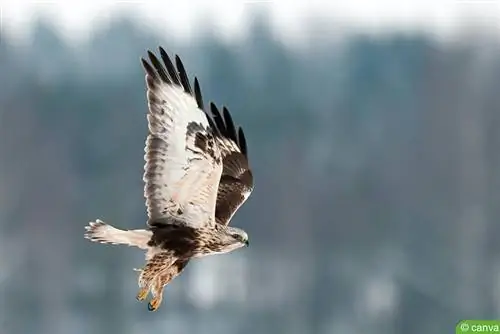
- Size 49 - 59 centimeters
- resembles the common buzzard
- Plumage brighter
- cold gray with dark spots on the belly
- white tail with dark terminal band
- “shakes” similar to the kestrel
- feeds on small rodents
- regular guest in winter
- Migratory bird
Tip:
The rough-legged hawk is able to detect ultraviolet light and can thus track down its prey based on urine and feces.
Honey buzzard (Pernis apivorus)
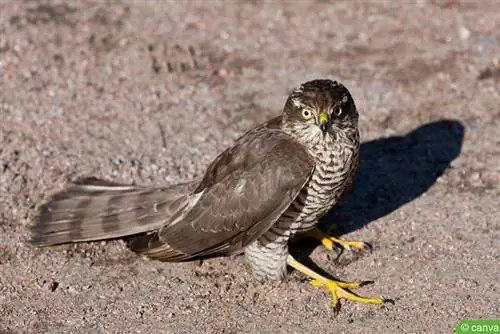
- long, narrow wings
- three-banded tail
- Very small head in proportion
- is stretched forward like a pigeon in flight
- several color variations of the plumage possible
- Habitat in forest areas
- breeds in the local latitudes
- has a typical two-syllable call
- Food consists of wasps and wasp larvae
- Migratory bird
Note:
In birds of prey, the tail is often called a thrust, and the wings are also called wings.
Falcon (Falco)
The agile falcons are among the fastest fliers among the birds of prey in Germany. They are slender with pointed, long wings that flap quickly. The falcons succeed in hunting prey in rapid flight.
Tree Falcon (Falco subbuteo)
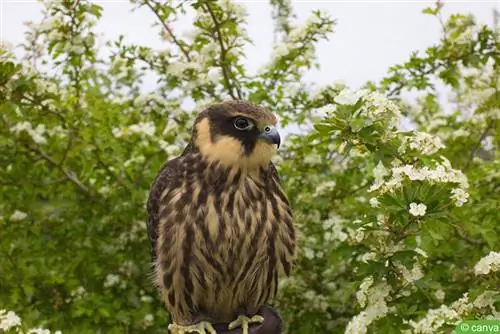
- looks similar to the peregrine falcon
- is smaller
- rust red legs
- longitudinal stripes in the abdominal area
- sails in flight
- Prey insects and small birds
- Hunting takes place in rapid flight
- Migratory bird
Merlin (Falco columbarius)
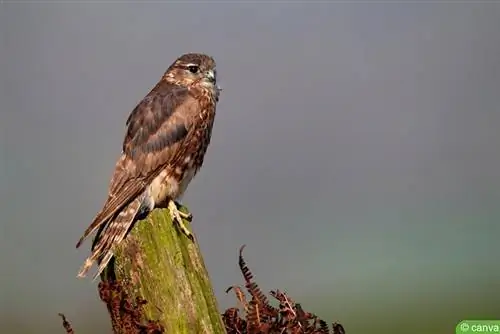
- smallest falcon in Europe
- approx. 28 centimeters
- Females larger than males
- clear stripes in the stomach area
- male slate blue
- Female brown
- does not breed in Germany
- Migratory bird
- often seen here in winter
- Food Large Insects, Birds and Small Mammals
Red-footed Falcon (Falco vespertinus)
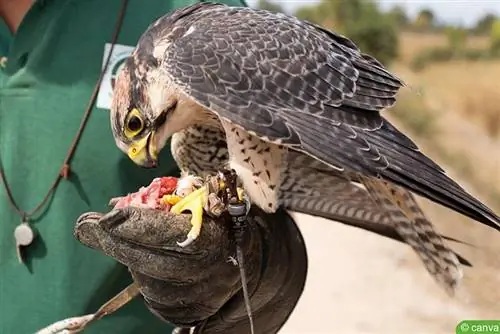
- small falcon species
- smaller than pigeons
- Male rusty red feet and legs
- Female head and belly side rusty red
- Gray-banded back
- Migratory bird
- hardly breeds in Germany
- Food from insects such as dragonflies or beetles
Note:
The red-footed falcon can usually be observed in spring in Germany on the way back to its breeding grounds. These are located in Eastern and Southeastern Europe.
Kestrel (Falco tinnunculus)
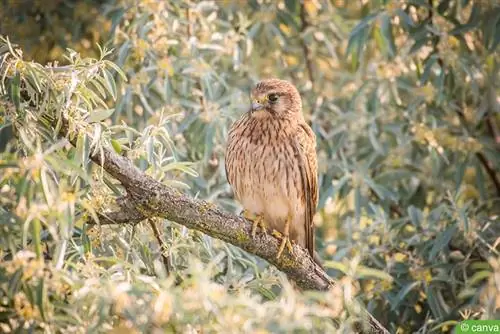
- Bird of the Year 2007
- largest species of falcon at 38 centimeters tall
- can be easily recognized by the “shaking”
- Female banded brown on head and tail
- Men are gray here
- is very common in Germany
- likes to hang out near tall buildings
- Prey large insects, beetles, small birds, voles lizards
- will be around 15 years old
Note:
The kestrel, but also various other birds of prey, “shake”, which means they stay in one place in the air while flapping their wings, with their tails spread.
Peregrine Falcon (Falco peregrinus)
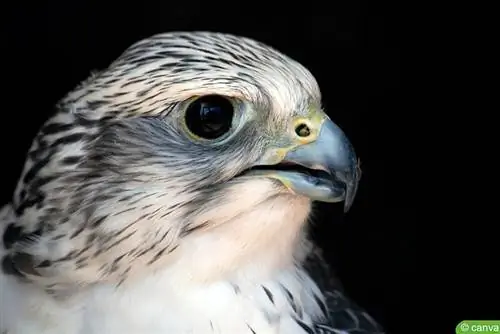
- largest species of falcon
- between 38 and 50 centimeters
- Male darker and larger than female
- Young birds brown, underside striped
- adult birds banded on the belly
- rare breeding bird in Germany
- rarely pulls through
- preferred food is birds
- Life expectancy up to 15 years
Hawk (Accipiter gentilis)
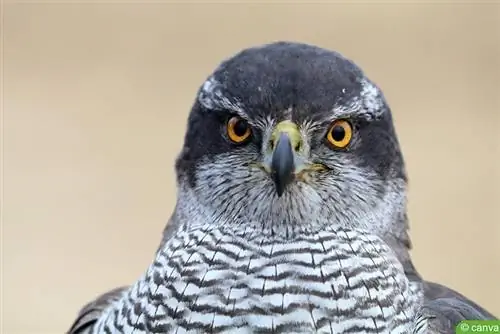
Goshawks are not differentiated into different species. The birds of prey have the following characteristics:
- about the size of the buzzard
- Females often smaller
- Young birds have yellowish plumage on the belly
- Adult birds black and white
- wide, short wings
- more agile and fast flight
- Surprise attacks rule the hunt
- are rarely observed
- Habitat woody plants and forests
- but often close to the city like in a park
Note:
In a large population, the hawk can certainly become a problem for native and threatened animal species, such as grouse. Otherwise, the bird of prey prefers birds and small mammals as prey, although the prey birds can be larger than itself.
Milans (Milvinae)
Kites are very slender birds of prey that have a long, forked tail and long wings. What is particularly characteristic here is the rather slow beating of the wings.
Red Kite (Milvus milvus)
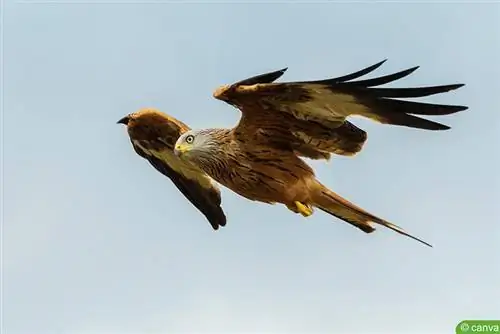
- also called “King of the Skies”
- about the size of the buzzard
- reddish plumage
- angled, long wings
- deep forked long tail
- feeds on small mammals
- Carrion is also part of the diet
- Migratory bird
Black Kite (Milvus migrans)
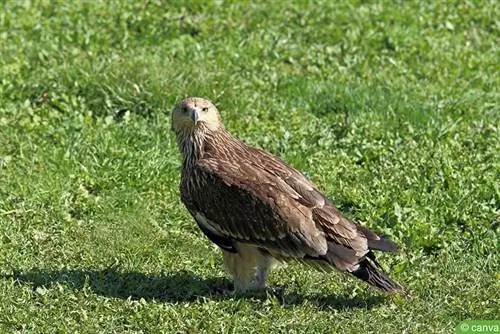
- about 58 centimeters tall
- Females are a little bigger
- darker plumage than the red kite
- Tail less forked
- commonly found in bodies of water
- loves socializing
- prefers lizards, snakes, fish, birds and small mammals
- Dead fish are also part of the diet
- breeds in trees
- Migratory bird
- can live up to 20 years
Sparrowhawk (Accipiter nisus)
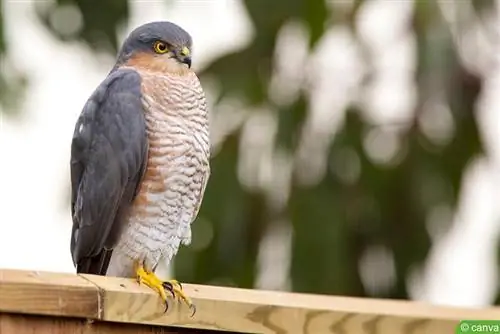
The sparrowhawk, of which there are no subspecies, looks very similar to the hawk and is often confused with it. However, the bird of prey is quite small:
- Size 32 to 37 centimeters
- Females larger than males
- wide and short wings
- black and white drawing
- both young and adult birds
- hidden habitat in forests
- Hunting flight directly over vegetation
- fast and maneuverable plane
- Attacks on prey are surprising
- prefers small bird species
Consecration (Circus)
The harriers look quite similar to kites and can easily be confused. However, the harriers lack the fork on the tail. In addition, the harriers fly in a low, rocking flight. If you look at them more closely, you will quickly notice the owl-like face, which makes them easier to recognize.
Hen Harrier (Circus cyaneus)
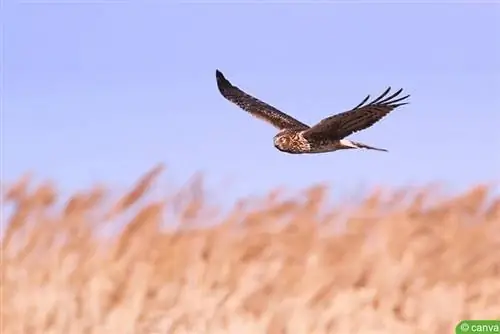
- Size 43 to 52 centimeters
- male ash gray
- Female brown
- both light spots on tail
- Ground breeders
- rarely occurs here
- Migratory bird in winter
- prefers natural habitats such as moors or swamps
- feeds on insects, birds and small rodents
Note:
Hen Harriers were breeding birds that used to live in Germany. Due to the increasing lack of habitat, the resident hen harriers are unfortunately almost extinct in this country and there are only a few populations left.
Marsh Harrier (Circus aeruginosus)
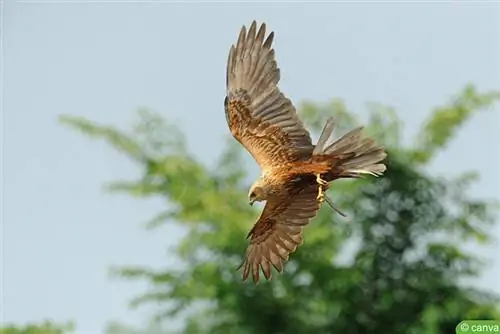
- 43 to 55 centimeters tall
- largest and most powerful type of harrier
- Male contrasting plumage
- Female white on wings and head
- lives in wetlands
- here in the reeds
- often breeding with several pairs next to each other
- Migratory bird
- Hunting in open landscape
- Prey insects, birds and small mammals
Steppe harrier (Circus macrourus)
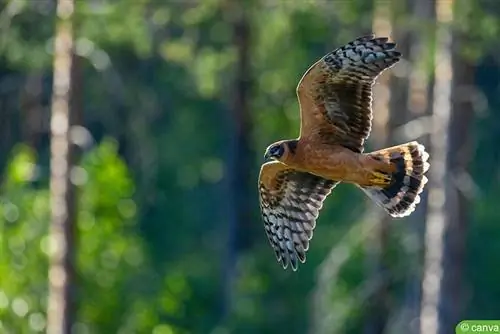
- Size between 43 to 48 centimeters
- not so common in Germany
- often at migration time
- looks very similar to hen harrier
- Male's belly area lighter than hen harrier
- open landscape preferred for breeding
- Migratory bird
- Hunting in illusionary search flight
- for small mammals and small birds
Note:
All species of harriers look very similar and are often indistinguishable even to experts when they are discovered in the wild. Because the differences are very minimal.
Meadow Harrier (Circus pygargus)
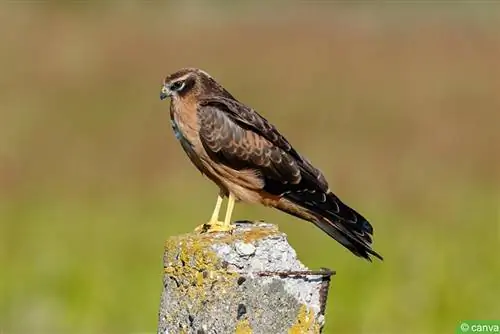
- Size 43 - 47 centimeters
- similar appearance of the hen harrier
- but less white on the tail
- Male also has a black narrow band on his wing
- also very slim and pointed wings
- preferred food lizards, young birds, small mammals and insects
- Migratory bird
- Ground breeders
- more and more often on agricultural land
- therefore critically endangered

